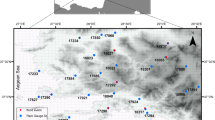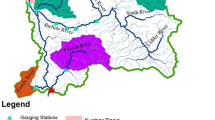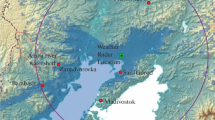Abstract
Floods due to heavy rainfall are one of the most frequent and widespread natural hazards. Rainfall is one of the key variables in flood modeling. For topographically steep catchments, flood modeling requires accurate rainfall sources in both time and space. The objective of this study is to compare different rainfall sources in physics-based distributed hydrologic model, (Weather Research and Forecasting) WRF-Hydro, in a data-scarce, small and topographically steep catchment. For this purpose, the model was calibrated and validated for the three catastrophic flood events that occurred in the Terme basin of eastern Black Sea region in Samsun, Turkey. The rainfall datasets include weather radar data and the Hydro-Estimator satellite rainfall product as nowcasting products, and WRF model precipitation data as a forecasting product and gauge-based data. Our results indicated that the tested rainfall products have different limitations and potentials depending on the rainfall process, so the accuracy of the results is greatly affected by the accuracy of rainfall products. Among the flood hydrographs, WRF precipitation data, bias-adjusted radar data and gauge data gave best Nash–Sutcliffe efficiency (NSE) results with calibrated parameters in simulations belonging to floods observed on November 22, 2014, August 2, 2015, and May, 28, 2016, respectively.









Similar content being viewed by others
References
Nyeko, M.: Hydrologic modelling of data scarce basin with SWAT model: capabilities and limitations. Water Resour. Manage 29, 81–94 (2015). https://doi.org/10.1007/s11269-014-0828-3
Bangira T (2013) Mapping of flash flood potential areas in the Western Kape, South Africa, using remote sensing and in situ data. Master Thesis, University of Twente Faculty of Geo-Information and Earth Observation (ITC)
Bitew, M.M.; Gebremichael, M.: Assessment of satellite rainfall products for streamflow simulation in medium watersheds of the Ethiopian highlands. Hydrol. Earth Syst. Sci. 15, 1147–1155 (2011)
Vasiloff, S.V.; Seo, D.-J.; Howard, K.W.; et al.: Improving QPE and very short term QPF: an initiative for a community-wide integrated approach. Bull. Am. Meteorol. Soc. 88, 1899–1911 (2007)
Habets, F.; LeMoigne, P.; Noilhan, J.: On the utility of operational precipitation forecasts to served as input for streamflow forecasting. J. Hydrol. 293, 270–288 (2004)
Petty, G.W.; Krajewski, W.F.: Satellite estimation of precipitation over land. Hydrol. Sci. J. 41, 433–451 (1996). https://doi.org/10.1080/02626669609491519
Sapiano, M.R.P.; Arkin, P.A.: An intercomparison and validation of high-resolution satellite precipitation estimates with 3-hourly gauge data. J. Hydrometeorol. 10, 149–166 (2009). https://doi.org/10.1175/2008JHM1052.1
Nikolopoulos, E.I.; Anagnostou, E.N.; Borga, M.: Using high-resolution satellite rainfall products to simulate a major flash flood event in Northern Italy. J. Hydrometeorol. 14, 171–185 (2013). https://doi.org/10.1175/JHM-D-12-09.1
Gourley, J.J.; Hong, Y.; Flamig, Z.L.; et al.: Hydrologic evaluation of rainfall estimates from radar, satellite, gauge, and combinations on Ft. Cobb basin, Oklahoma. J. Hydrometeorol. 12, 973–988 (2011). https://doi.org/10.1175/2011JHM1287.1
Mei, Y.; Nikolopoulos, E.I.; Anagnostou, E.N.; et al.: Error analysis of satellite precipitation-driven modeling of flood events in complex alpine terrain. Remote Sens. 8, 293 (2016). https://doi.org/10.3390/rs8040293
Nikolopoulos, E.I.; Anagnostou, E.N.; Hossain, F.; et al.: Understanding the scale relationships of uncertainty propagation of satellite rainfall through a distributed hydrologic model. J. Hydrometeorol. 11, 520–532 (2010). https://doi.org/10.1175/2009JHM1169.1
Zahidul, Islam; Yew, Gan Thian: Hydrologic modeling of the blue river basin using NEXRAD precipitation data with a semidistributed and a fully distributed model. J. Hydrol. Eng. 20, 04015015 (2015). https://doi.org/10.1061/(ASCE)HE.1943-5584.0001179
Vieux, B.E.; Bedient, P.B.: Estimation of rainfall for flood prediction from WSR-88D reflectivity: a case study, 17–18 October 1994. Weather Forecast. 13, 407–415 (1998). https://doi.org/10.1175/1520-0434(1998)013%3c0407:EORFFP%3e2.0.CO;2
Kalinga, O.A.; Gan, T.Y.: Semi-distributed modelling of basin hydrology with radar and gauged precipitation. Hydrol. Process. 20, 3725–3746 (2006). https://doi.org/10.1002/hyp.6385
Javelle, P.; Demargne, J.; Defrance, D.; et al.: Evaluating flash-flood warnings at ungauged locations using post-event surveys: a case study with the AIGA warning system. Hydrol. Sci. J. 59, 1390–1402 (2014). https://doi.org/10.1080/02626667.2014.923970
Li, Y.; Grimaldi, S.; Walker, J.P.; Pauwels, V.R.N.: Application of remote sensing data to constrain operational rainfall-driven flood forecasting: a review. Remote Sens. 8, 456 (2016). https://doi.org/10.3390/rs8060456
Shrestha, D.L.; Robertson, D.E.; Wang, Q.J.; et al.: Evaluation of numerical weather prediction model precipitation forecasts for short-term streamflow forecasting purpose. Hydrol. Earth Syst. Sci. 17, 1913–1931 (2013). https://doi.org/10.5194/hess-17-1913-2013
Lorenz, E.N.: The predictability of a flow which possesses many scales of motion. Tellus 21, 289–307 (1969). https://doi.org/10.1111/j.2153-3490.1969.tb00444.x
Rogelis, M.C.; Werner, M.: Streamflow forecasts from WRF precipitation for flood early warning in mountain tropical areas. Hydrol. Earth Syst. Sci. 22, 853–870 (2018)
Wu, X.: Quarterly numerical weather prediction model performance summary October to December 2009. Aust. Meteorol. Oceanogr. J. 60, 87–90 (2010)
Chintalapudi, S.; Sharif, H.O.; Furl, C.: High-resolution, fully distributed hydrologic event-based simulations over a large watershed in Texas. Arab. J. Sci. Eng. 42, 1341–1357 (2017). https://doi.org/10.1007/s13369-017-2446-x
Liang, X.; Lettenmaier, D.P.; Wood, E.F.; Burges, S.J.: A simple hydrologically based model of land surface water and energy fluxes for general circulation models. J. Geophys. Res. Atmos. 99, 14415–14428 (1994)
Arnold, J.G.; Atwood, J.D.; Benson, V.W.; et al.: Potential Environmental and Economic Impacts of Implementing National Conservation Buffer Initiative Sedimentation Control Measures. USDA, NRCS Staff Paper (1998)
Beven, K.J.; Kirkby, M.J.: A physically based, variable contributing area model of basin hydrology/Un modèle à base physique de zone d’appel variable de l’hydrologie du bassin versant. Hydrol. Sci. Bull. 24, 43–69 (1979). https://doi.org/10.1080/02626667909491834
Devia, G.K.; Ganasri, B.P.; Dwarakish, G.S.: A review on hydrological models. Aquat. Procedia 4, 1001–1007 (2015)
Maidment, D.R.: Conceptual framework for the national flood interoperability experiment. JAWRA J. Am. Water Resour. Assoc. 53, 245–257 (2017)
Gochis, D.J.; Yu, W.; Yates, D.N.: The WRF-Hydro Model Technical Description and User’s Guide, Version 3.0, NCAR Technical Document (2015)
Yucel, I.; Onen, A.; Yilmaz, K.K.; Gochis, D.J.: Calibration and evaluation of a flood forecasting system: utility of numerical weather prediction model, data assimilation and satellite-based rainfall. J. Hydrol. 523, 49–66 (2015)
Senatore, A.; Mendicino, G.; Gochis, D.J.; et al.: Fully coupled atmosphere-hydrology simulations for the central Mediterranean: impact of enhanced hydrological parameterization for short and long time scales. J. Adv. Model. Earth Syst. 7, 1693–1715 (2015)
Arnault, J.; Wagner, S.; Rummler, T.; et al.: Role of runoff-infiltration partitioning and resolved overland flow on land-atmosphere feedbacks: a case study with the WRF-Hydro coupled modeling system for West Africa. J. Hydrometeorol. 17, 1489–1516 (2015). https://doi.org/10.1175/JHM-D-15-0089.1
Kerandi, N.; Arnault, J.; Laux, P.; et al.: Joint atmospheric-terrestrial water balances for East Africa: a WRF-Hydro case study for the upper Tana River basin. Theor. Appl. Climatol. 131, 1337–1355 (2018)
Silver, M.; Karnieli, A.; Ginat, H.; et al.: An innovative method for determining hydrological calibration parameters for the WRF-Hydro model in arid regions. Environ. Model. Softw. 91, 47–69 (2017)
Sensoy, S.: The mountains influence on Turkey climate. Paper presented at the BALWOIS conference on water observation and information system for decision support, Macedonia, May 25–29 (2010).
Oyj, V.: Weather Radar Documentation User Guide IRIS Radar (2017)
Marshall, J.S.; Palmer, W.M.K.: The distribution of raindrops with size. J. Meteorol. 5, 165–166 (1948)
Ozkaya, A.: Assessment of different rainfall products in flood simulations. Ph.D. Thesis, Middle East Technical University (2017)
Ozkaya, A.; Akyurek, Z.: Evaluating the use of bias-corrected radar rainfall data in three flood events in Samsun, Turkey. Nat. Hazards 98, 643–674 (2019). https://doi.org/10.1007/s11069-019-03723-z
Scofield, R.A.; Kuligowski, R.J.: Status and outlook of operational satellite precipitation algorithms for extreme-precipitation events. Weather Forecast. 18, 1037–1051 (2003)
Vicente, G.A.; Scofield, R.A.; Menzel, W.P.: The operational GOES infrared rainfall estimation technique. Bull. Am. Meteorol. Soc. 79, 1883–1898 (1998). https://doi.org/10.1175/1520-0477(1998)079%3c1883:TOGIRE%3e2.0.CO;2
NOAA’s Office of Satellite and Product Operations. In: Global Hydro-Estimator—Algorithm Description. https://www.ospo.noaa.gov/Products/atmosphere/ghe/algo.html. Accessed 10 Sept 2018
Yucel, I.: Assessment of a flash flood event using different precipitation datasets. Nat. Hazards 79, 1889–1911 (2015)
Skamarock, W.C.; Klemp, J.B.; Dudhia, J.: Prototypes for the WRF (Weather Research and Forecasting) model. In: Preprints, Ninth Conference Mesoscale Processes, J11–J15, Am. Meteorol. Soc., Fort Lauderdale, FL (2001)
Yucel, I.; Onen, A.: Evaluating a mesoscale atmosphere model and a satellite-based algorithm in estimating extreme rainfall events in northwestern Turkey. Nat. Hazards Earth Syst. Sci. 14, 611–624 (2014)
Chen, C.-S.; Lin, Y.-L.; Peng, W.-C.; Liu, C.-L.: Investigation of a heavy rainfall event over southwestern Taiwan associated with a subsynoptic cyclone during the 2003 Mei-Yu season. Atmos. Res. 95, 235–254 (2010)
Liu, J.; Bray, M.; Han, D.: A study on WRF radar data assimilation for hydrological rainfall prediction. Hydrol. Earth Syst. Sci. 17, 3095–3110 (2013)
Hong, S.-Y.; Dudhia, J.; Chen, S.-H.: A revised approach to ice microphysical processes for the bulk parameterization of clouds and precipitation. Mon. Weather Rev. 132, 103–120 (2004)
Kain, J.S.: The Kain-Fritsch convective parameterization: an update. J. Appl. Meteorol. 43, 170–181 (2004)
Que, L.-J.; Que, W.-L.; Feng, J.-M.: Intercomparison of different physics schemes in the WRF model over the Asian summer monsoon region. Atmos. Ocean. Sci. Lett. 9, 169–177 (2016). https://doi.org/10.1080/16742834.2016.1158618
Wöhling, T.; Samaniego, L.; Kumar, R.: Evaluating multiple performance criteria to calibrate the distributed hydrological model of the upper Neckar catchment. Environ. Earth Sci. 69, 453–468 (2013)
Nash, J.E.; Sutcliffe, J.V.: River flow forecasting through conceptual models part I—A discussion of principles. J. Hydrol. 10, 282–290 (1970)
Mitchell, K.E.: The Community Noah Land Surface Model (LSM)—user’s guide (v2. 2) (2001)
Cencetti, C.; Rosa, P.D.; Fredduzzi, A.; et al.: A statistical test for drainage network recognition using MeanStreamDrop analysis. Geomat. Nat. Hazards Risk 6, 534–553 (2015)
Frissell, C.A.; Liss, W.J.; Warren, C.E.; Hurley, M.D.: A hierarchical framework for stream habitat classification: viewing streams in a watershed context. Environ. Manag. 10, 199–214 (1986)
Tarboton, D.G.; Bras, R.L.; Rodriguez-Iturbe, I.: On the extraction of channel networks from digital elevation data. Hydrol. Process. 5, 81–100 (1991)
Seo, Y.; Schmidt, A.R.: Evaluation of drainage networks under moving storms utilizing the equivalent stationary storms. Nat. Hazards 70, 803–819 (2014)
Özcan, E.: Sel Olayı ve Türkiye. Gazi Eğitim Fakültesi Dergisi 26, 35–50 (2006). https://doi.org/10.17152/gefd.15296
Huang, D.; Gao, S.: Impact of different cumulus convective parameterization schemes on the simulation of precipitation over China. Tellus A: Dyn. Meteorol. Oceanogr. 69, 1406264 (2017). https://doi.org/10.1080/16000870.2017.1406264
Acknowledgements
Rainfall datasets including WRF, radar and gauge were provided by the General Directorate of Meteorology, and discharge data were provided by the State Hydraulic Works. A. Ozkaya acknowledges support of the Scientific and Technological Research Council of Turkey (TUBITAK) BIDEB 2211-A PhD scholarship program.
Author information
Authors and Affiliations
Corresponding author
Rights and permissions
About this article
Cite this article
Ozkaya, A., Akyurek, Z. WRF-Hydro Model Application in a Data-Scarce, Small and Topographically Steep Catchment in Samsun, Turkey. Arab J Sci Eng 45, 3781–3798 (2020). https://doi.org/10.1007/s13369-019-04251-5
Received:
Accepted:
Published:
Issue Date:
DOI: https://doi.org/10.1007/s13369-019-04251-5




